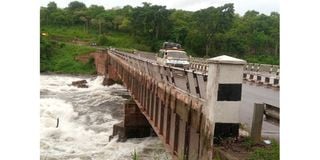Karuma Bridge closure: A crisis that demands urgent govt action

A commuter taxi crosses Karuma Bridge. PHOTO | BILL OKETCH
What you need to know:
Northern Uganda relies heavily on Karuma Bridge for the free flow of goods, services, and people.
The recent closure of Karuma Bridge has thrust Northern Uganda into an economic and social crisis, the gravity of which appears to have been grossly underestimated by the authorities. Karuma Bridge is not just a physical connection; it is the lifeline between the greater Northern region and the rest of Uganda, including critical trade routes to South Sudan. This decision, seemingly taken without the proper assessment of its wider implications, has already caused significant harm to the people and businesses of Northern Uganda. The lack of foresight, coupled with the limited provision of alternative routes, has left citizens grappling with severe disruptions that could have been avoided if the government had given this issue the serious attention it deserves.
Northern Uganda relies heavily on Karuma Bridge for the free flow of goods, services, and people. The bridge is the main artery for trade between the region, South Sudan, and other parts of Uganda. Its closure means that businesses across Gulu, Kitgum, Lira, and the entire Acholi and Lango sub-regions have been cut off from essential supplies and markets. Agricultural produce that sustains the livelihoods of countless households is unable to reach its destinations, and traders find themselves stuck with perishable goods that are losing value by the day. The transport sector has also been hit hard, with the price of transportation skyrocketing due to the longer detours and the additional costs imposed by the alternative routes.
Socially, the impact is no less devastating. Access to essential services, including healthcare and education, has been compromised. Families are struggling to reach hospitals and clinics, and students face difficulty traveling to school. The disruption of daily life is palpable, and the people of Northern Uganda feel abandoned in their time of need. The ripple effect on South Sudan, which relies on Northern Uganda for many of its imports and services, has also added to the regional tension, deepening the crisis.
The need for high-level government attention.
This is not a matter that should have been handled lightly, nor should it have been treated as a routine maintenance issue. The closure of Karuma Bridge has caused such widespread suffering that it warranted immediate government intervention at the highest levels. Emergency meetings should have been convened to explore all possible alternatives, with input from affected stakeholders, including businesses, community leaders, and local governments.
One of the most glaring oversights was the failure to ensure that alternative routes were made free and easily accessible. The government’s decision to direct traffic through Murchison Falls National Park, for instance, has imposed an unjust burden on the people of Northern Uganda. Park fees, which are typically charged to tourists, are now being levied on ordinary citizens simply trying to continue their daily lives. It is unacceptable that those who are already facing hardship due to the bridge closure are being further punished by having to pay fees to travel across what should be public roads. A waiver on these fees should have been implemented from the start. The government must take immediate steps to remove this financial burden from its citizens, allowing free passage through these routes until Karuma Bridge is reopened.
In a situation of this magnitude, the government should have explored all viable alternatives to ease the crisis, including the use of air transport. Emergency airlifts for goods and essential services could have been organized to alleviate the pressure on road transport. The decision to overlook such options further underscores the lack of seriousness with which this crisis has been treated.
It is not too late for the government to rectify its mishandling of this situation, but time is running out. Leaders from the greater North must urgently call for an emergency meeting to put pressure on the government to provide real solutions. This is not the time for silence or complacency. The people of Northern Uganda are watching closely, and they will judge their leaders by how they respond to this crisis. If the leadership fails to act now, it risks losing the trust and confidence of the people, who may feel abandoned in their hour of need.
The government must rise to the occasion and prioritize the people over bureaucratic processes.
Waivers on park fees, provision of free and accessible alternative routes, and the exploration of air transport must be immediately implemented. Anything less would be a failure of leadership and a betrayal of the citizens who depend on Karuma Bridge for their livelihoods, health, and well-being.
The closure of Karuma Bridge should never have reached this level of chaos. A high-level government response, led by empathy and urgency, is the only way to prevent further suffering and to restore the trust of the people of Northern Uganda.
John Opira, Gulu [email protected]




